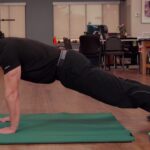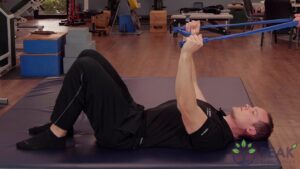Plank Exercise | Early Intervention Ergonomics
What is the Plank Exercise?
The plank exercise is a popular core-strengthening exercise that targets several muscle groups, including the abdominals, back, shoulders, and glutes. It is performed by assuming a position similar to a push-up, but instead of supporting yourself with your hands, you support your body weight on your forearms and toes.
Here’s how to perform the plank exercise:
- Start by positioning yourself face-down on the floor or an exercise mat.
- Bend your elbows and place your forearms on the ground, with your elbows directly beneath your shoulders.
- Extend your legs behind you, resting your weight on your toes.
- Your body should form a straight line from your head to your heels, with your core muscles engaged.
- Maintain a neutral neck position by looking down at the floor, avoiding arching or rounding your back.
- Hold this position for a specific amount of time, usually starting with 20 to 30 seconds, and gradually increasing the duration as you build strength.
- Breathe steadily throughout the exercise.
The plank exercise is effective for building core strength, improving stability, and enhancing overall body control. It can be modified to suit different fitness levels by performing variations such as side planks, plank rotations, or incorporating movements like leg lifts or arm reaches. It’s important to maintain proper form and listen to your body, starting with shorter durations and gradually progressing as you become more comfortable and stronger.
Early Intervention Benefits of this Exercise
The plank exercise offers several early intervention health benefits. Here are some of the key advantages:
Injury prevention: A strong core and improved overall strength contribute to better stability and balance, reducing the risk of injuries, especially in the lower back and hips. The plank exercise helps develop the muscles that support and protect these areas.
Core strength: Planks primarily target the muscles of the core, including the deep abdominal muscles, obliques, and lower back muscles. By regularly performing planks, you can develop a strong and stable core, which is essential for proper posture, spinal alignment, and overall functional strength.
Improved posture: Planks engage the muscles that support the spine, helping to improve posture and reduce the risk of developing poor postural habits. Strengthening the core muscles can also alleviate lower back pain and promote better spinal alignment.
Enhanced overall strength: Planks are not just a core exercise; they also engage other major muscle groups such as the shoulders, glutes, and legs. Holding the plank position requires these muscles to work together, leading to improved overall strength and muscular endurance.
Increased flexibility: Performing planks helps to stretch and strengthen various muscle groups, including the shoulders, hamstrings, and arches of the feet. Over time, this can lead to increased flexibility and joint mobility.
Functional fitness: Planks are a functional exercise that translates to daily activities and work productivity. A strong core is vital for performing everyday tasks, such as lifting, bending, and twisting, with proper form and reduced risk of injury.
If you have an injury or illness, consult with a health care professional before attempting.
This early intervention exercise improves overall health & fitness and helps reduce work-related injuries.


